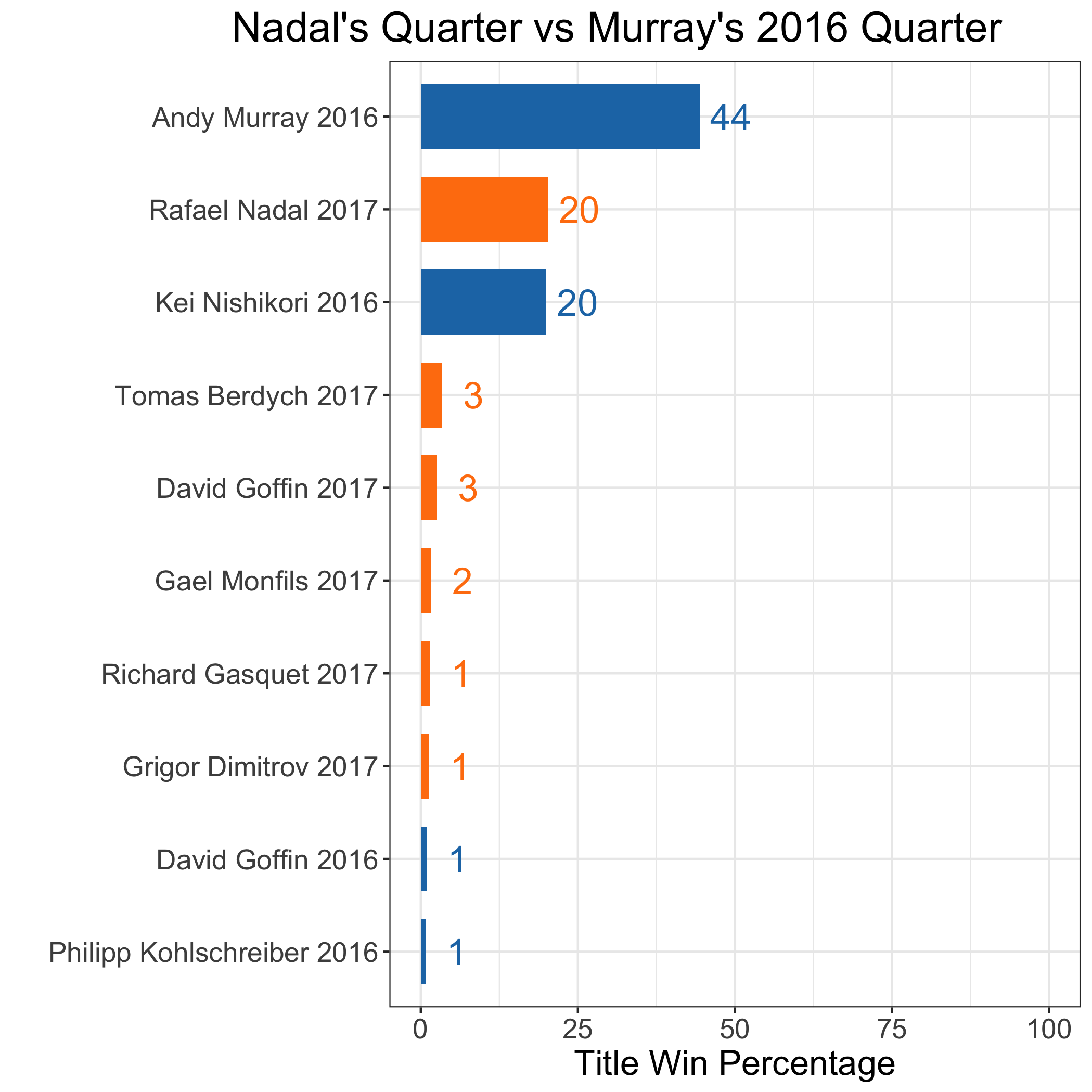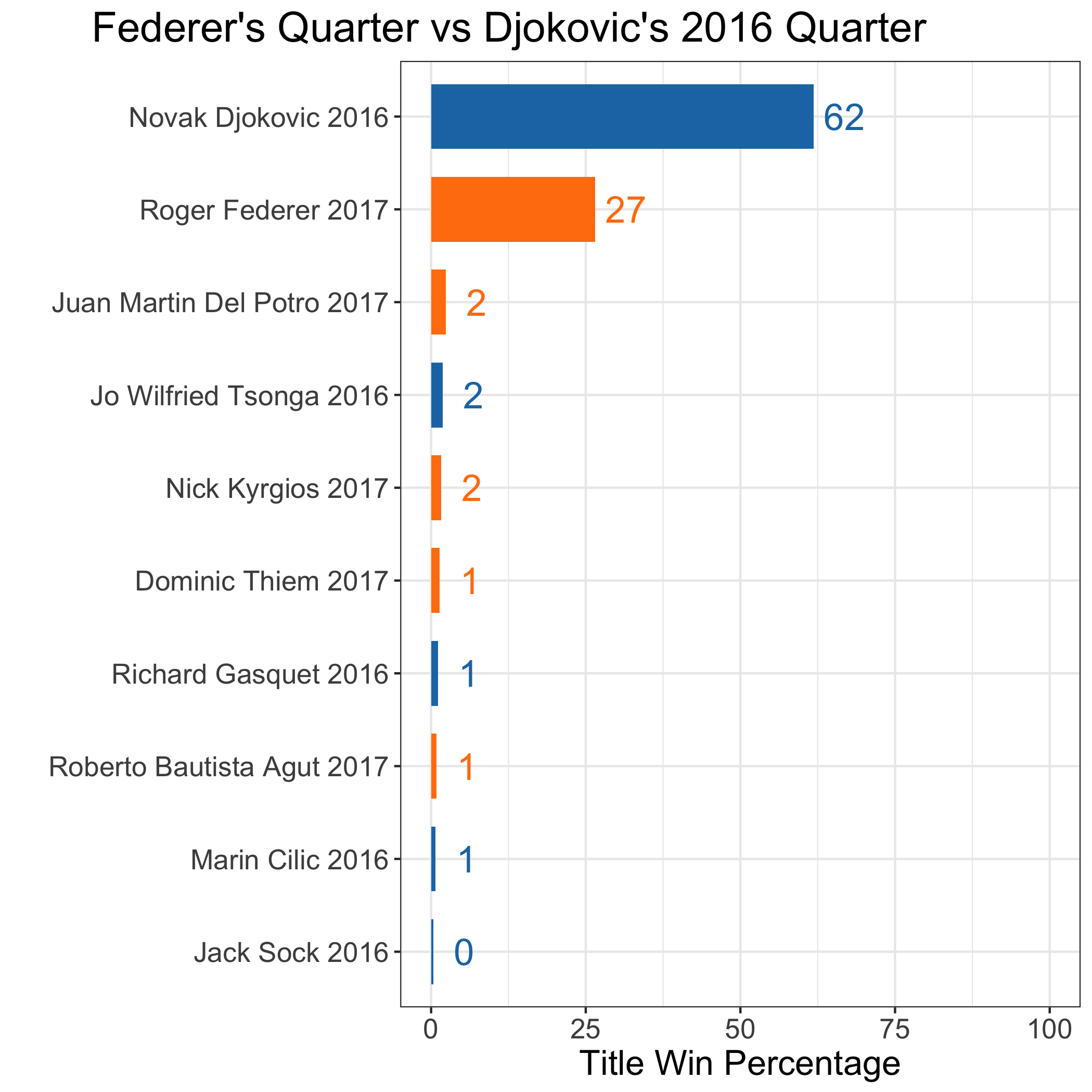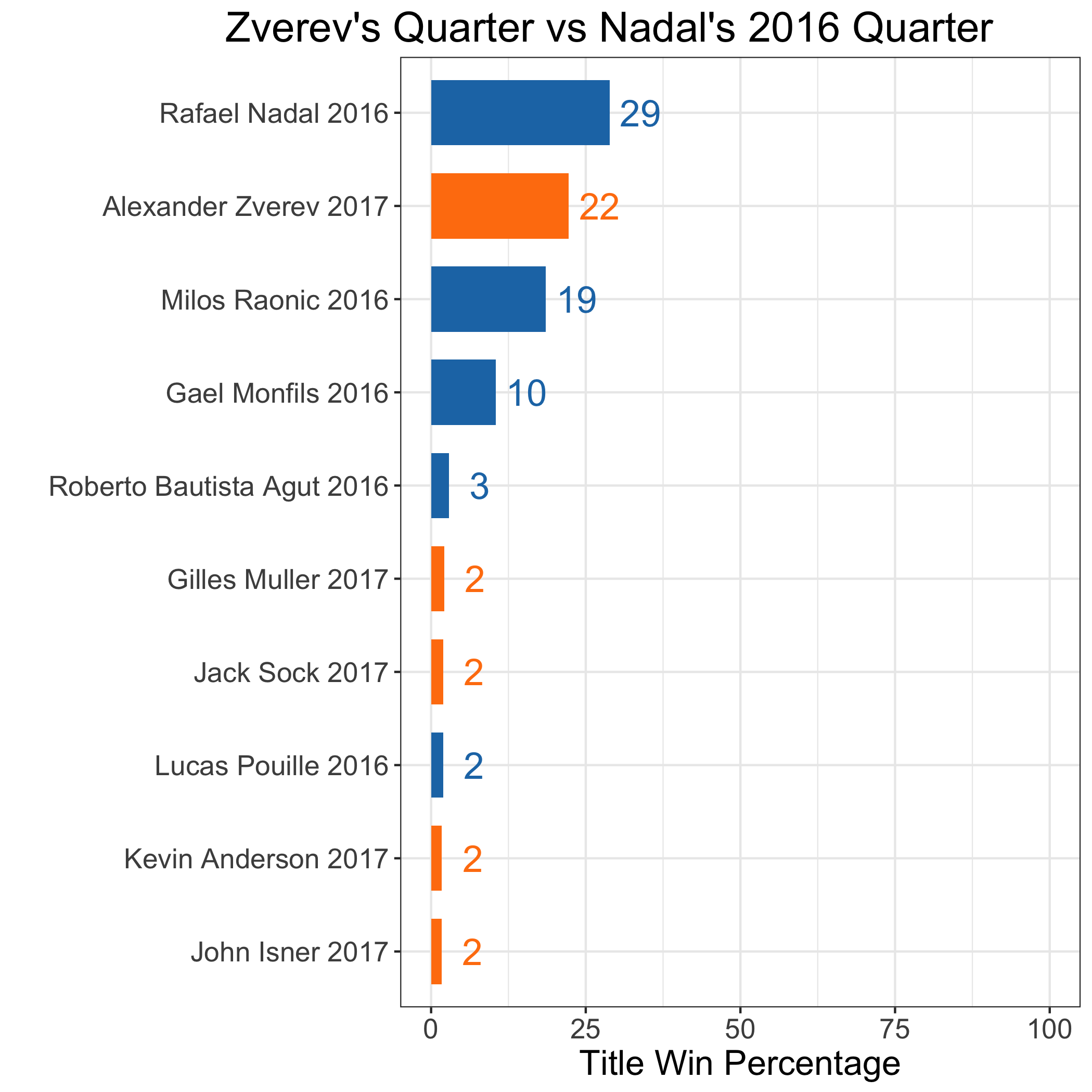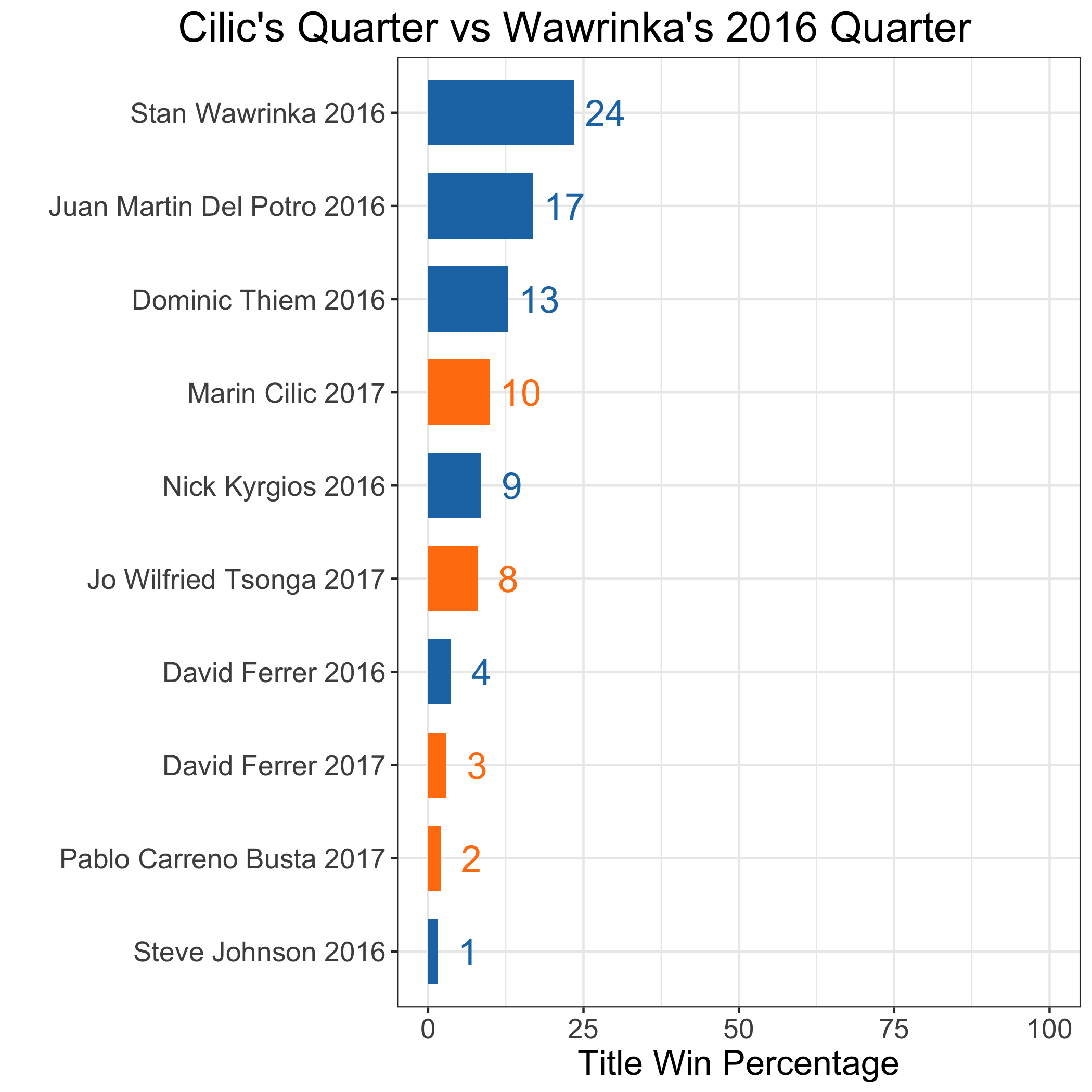The 2016 US Open Men Would Smash 2017
There has been a lot of talk about the lacklustre men’s field at this year’s US Open. What better way to put this idea to the test than to have the 2017 US Open men’s draw go head-to-head against the draw of 2016?
When the US Open men’s draw was released last week, it was nothing if ‘meh’-inducing. Not only had 3 of the top 10 already dropped out but Rafael Nadal and Roger Federer were put into the same half. Things took a turn for the worse when Andy Murray announced that a still rusty hip was going to force him to skip the last Grand Slam of the year. That decision dropped the top 10 attendees to just 6, an all-time low for the Open.
Just think back to the situation a year ago and you can appreciate how much the state of the tour has changed.
Going into the 2016 US Open, Novak Djokovic was in the No. 1 position and had an intimidating all-surface Elo of 2496, just under his career peak Elo. Rafael Nadal was the 4th seed and had an Elo going into the event of 2231. The absence of Roger Federer couldn’t be ignored, but the level of the top seed in each quarter made for a heated 7 rounds.
In 2017, the absence of 3 of the 5 highest ranked men’s players put Rafael Nadal in the No. 1 position with an Elo or 2257, little more than marginally better than where he was as the 4th seed in 2016. After the reshuffling to adjust for Murray’s withdrawal, Marin Cilic took the top spot in the weakest quarter and entered the draw with an Elo rating of 2093. That is only 50 Elo points ahead of where Cilic was in the 2016 US Open, when he was the 7th seed.
So, yes, a lot has changed in a year.
But the contrast in the form of the top seeds is only part of what has driven the chatter about the 2017 US Open field. The imbalance in the draw has also been a source of disappointment and even ire. With the bottom half of the draw having just one player with a Major title to his name, some tennis writers have commented that any ambulatory competitor has a fighting chance of reaching a semifinal. Not the kind of situation to inspire casual tennis fans to tune in.
Still, we have to consider that most assessments of the draw are based on opinion and personal favourites, which raises the question of how we can objectively assess the quality (or inadequacy) of this year’s men’s field.
One way I think we can fairly judge the 2017 US Open men’s draw against recent draws is to have the 2017 competitors go head-to-head against the US Open players of 2016. Imagine you could have each quarter of 2017 go up against the corresponding quarter in 2016 in a 64-draw tournament. What better way to determine the state of today’s play compared to one year ago?
Obviously, we can’t turn back time and play out such an event for real (it would require GOT-like suspension of belief to pull that off). But we can use tried-and-true prediction methods to simulate a 2017 vs 2016 last-man-standing contest.
A little more about how I design each tournament. First, I match the top 4 seeds in 2017 with their corresponding 2016 seed according to their pre-tournament Elo. So, for example, this means I pit Roger Federer’s quarter in 2017 against Novak Djokovic’s in 2016 because these players had the highest Elo ratings in their event year.
Once each 2017 and 2016 quarter is matched, I combine the 64 players and order them in the draw as they would be using standard tournament rules, again, using Elo to seed players. I then simulate the outcome of each round of the event according to the win expectations implied by the Elo ratings of the players picked to play each other. I repeat this process 10,000 times and record how often each player ends up in the champion position.
Because we are interested in how the strength of each tournament compared at its start, we ignore the results of the first week of the 2017 US Open and include everyone as they were positioned at the start of the event.
Rafael Nadal’s Quarter
In an event with 2017 Nadal and 2016 Murray, Andy Murray would sit comfortably on top of the list of most likely victors. In fact, 2016 Murray would have more than double the odds of taking the title compared to 2017 Nadal. Even 2016 Nishikori would have the same statistical chance of winning the event as 2017 Nadal.

Although the overall level of the 2017 field doesn’t come close to where Murray was in 2016, we do find five of the 2017 quarter in the top 10 strongest competitors. This gives some basis to conclude that this 2017 quarter had depth.
Roger Federer’s Quarter
Turning to Federer’s quarter, we see that 2016 Djokovic would have crushed the 2017 field if he played to his expected level. Having more than a 60% chance of winning a tournament that includes many people’s top pick to take the trophy in 2017 shows from what heights Djokovic has regrettably fallen in so short time.

Beyond Djokovic and Federer, the chances even out dramatically and tell us that the form of all but the top seed were nearly comparable for the 2016 and 2017 competitors in these quarters.
Alexander Zverev’s Quarter
When Alexander Zverev’s 2017 quarter goes up against Nadal 2016 US Open quarter, we see that the top 2016 seed once again emerges as the strongest competitor. Unlike the other 2017 quarters, this is the first where we see a clear separation in strength among the rest of the 2016 and 2017 field. The third quarter not only picks a 2016 player as the most likely winner of a 2016 vs 2017 event, four of the top 5 most probable winners are 2016.

Marin Cilic’s Quarter
The dominance of the 2016 draw is even more pronounced when we turn to Cilic’s quarter. The top 3 winners in a quarter-vs-quarter event are 2016 players, with top 2017 seed Marin Cilic being only the 4th most likely to win the event, barely edging out 2016 Nick Kyrgios.

These numerical experiments confirm that the strength of the 2017 men’s draw is a shadow of 2016’s. It also shows why complaints about the imbalanced bottom half are justified.
It’s difficult to look at these results and not feel disappointed. Add to that the fact that many of the statistically stronger 2017 players have already exited (Cilic, Zverev, etc.) or seem just on the verge of exiting (Federer) and you might be ready to throw in the towel on the 2017 US Open men. But this kind of chaos could create just the right conditions for a virtual unknown to break onto the scene à la Boris Becker at the 1985 Wimbledon Championships, Goran Ivanisevic at the 2001 Wimbledon, or Mats Wilander at the 1982 French Open. To see another underdog story like one of these emerge in the second week would be more than reason enough to keep watching.
The code and data for this post can be found here.

